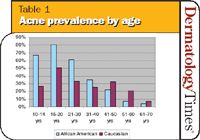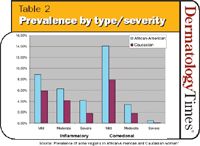- Case-Based Roundtable
- General Dermatology
- Eczema
- Chronic Hand Eczema
- Alopecia
- Aesthetics
- Vitiligo
- COVID-19
- Actinic Keratosis
- Precision Medicine and Biologics
- Rare Disease
- Wound Care
- Rosacea
- Psoriasis
- Psoriatic Arthritis
- Atopic Dermatitis
- Melasma
- NP and PA
- Skin Cancer
- Hidradenitis Suppurativa
- Drug Watch
- Pigmentary Disorders
- Acne
- Pediatric Dermatology
- Practice Management
- Prurigo Nodularis
- Buy-and-Bill
Article
Women's acne symptoms highly variable: Race, age significant severity factors
Boston - Acne is a common skin disorder among women of all ethnic and racial groups, but there appear to be distinct differences in its epidemiology depending on demographic features, according to the results of a study undertaken by Harvard University researchers.

The study is designed to characterize acne prevalence, subtype distribution and severity among women of various ethnic and racial backgrounds as well as the prevalence of post-lesional scarring and pigmentary changes.

Data analysis
Analyses of the data showed that the prevalence rates of both inflammatory and comedonal acne subtypes were higher overall in black women compared with Caucasian women.
When the study participants were divided into subgroups by age, teenagers among both black and Caucasian women had the highest rates of acne, and the prevalence remained higher among blacks in age subgroups including women up to 40 years old. However, Caucasians were more often affected by acne than blacks among older women.
"Available acne prevalence data are decades old and based predominantly on studies of Caucasian women. This investigation was designed to explore some recent anecdotal evidence that acne is becoming more common in older individuals and to gather information on prevalence in different ethnic and racial groups," explains Alexis C. Perkins, B.S., a Harvard Medical School student and Doris Duke Clinical Research Fellow, department of dermatology, Harvard Medical School.
Diagnosis
Photographs taken of the left side of the face of each participant were used to determine whether acne was present.
Investigators applied two methods to diagnose acne - the published Leeds criteria and a second set of criteria they created specifically for this study that was based on the range of disease noted among the enrollees as well as patient perceptions of acne. In women with a positive diagnosis, the acne was further categorized as to the presence of inflammatory and comedonal subtypes and its severity (very mild, mild, moderate or severe).
"The Leeds criteria are representative of most acne severity grading scales, which are instruments created for use in acne treatment studies and therefore focus on moderate-to-severe inflammatory acne," Ms. Perkins says. "However, when we began applying those criteria in this more general population, we realized we were excluding many women with skin disease typical of what practitioners see in daily practice and that is bothersome to patients. The population-defined criteria we created set the bar quite a bit lower than the scales used in treatment trials, but we consider them to be more clinically relevant for defining acne prevalence."
Using the Leeds criteria, acne was diagnosed in 2.7 percent of the Caucasian women and 6 percent of the black women, whereas the prevalence rates in those two groups increased to 37 percent and 22 percent, respectively, when the population-based criteria were applied. Inflammatory acne was slightly more prevalent than comedonal acne in both the Caucasian and black women. In both racial groups, the majority of acne was very mild to mild, although the proportion of women with moderate or severe disease was higher among blacks compared with the Caucasians.





